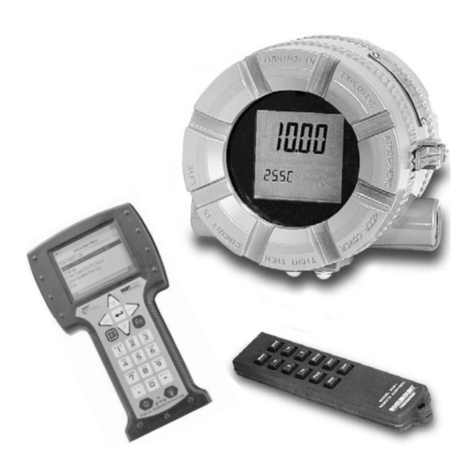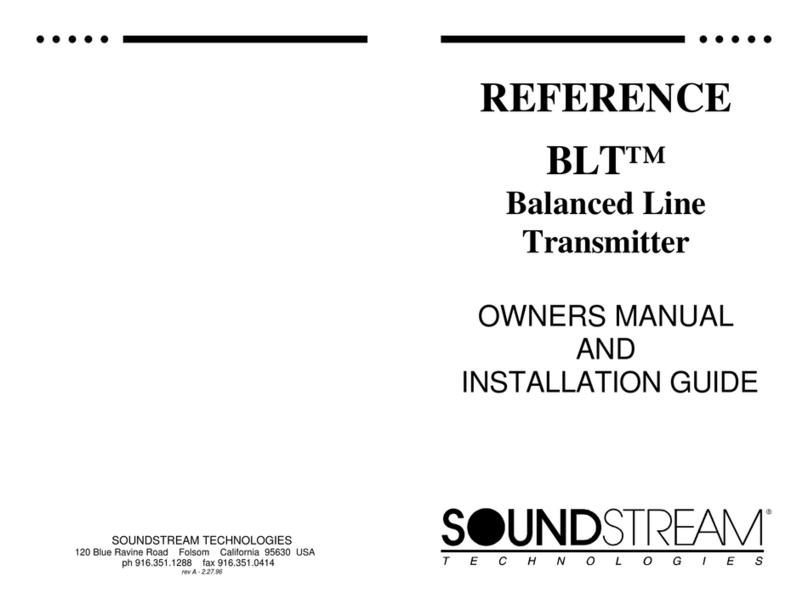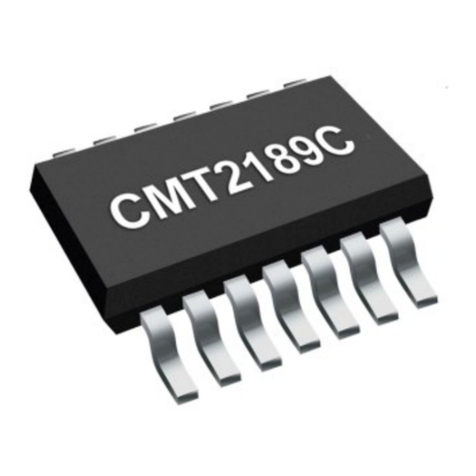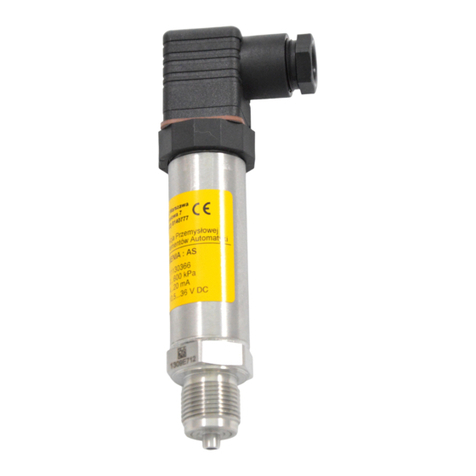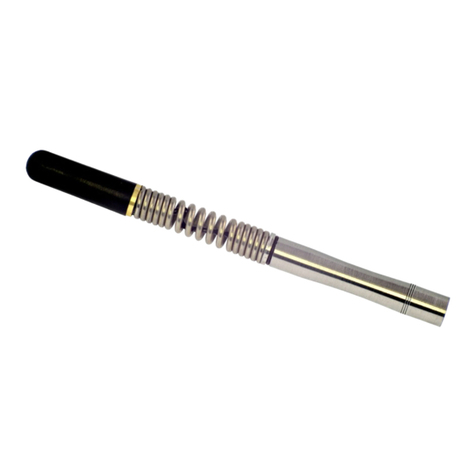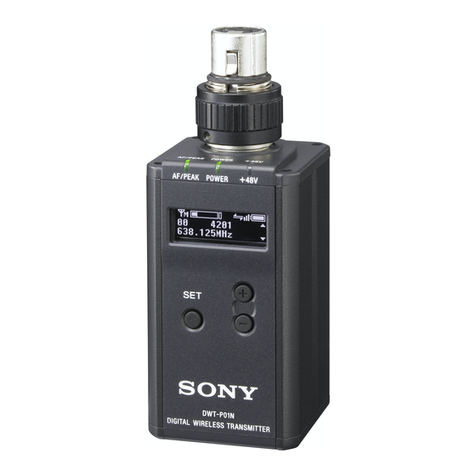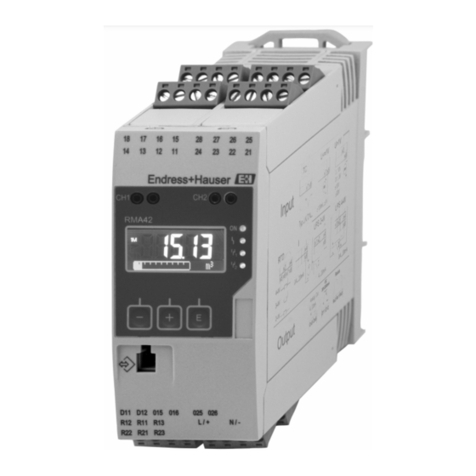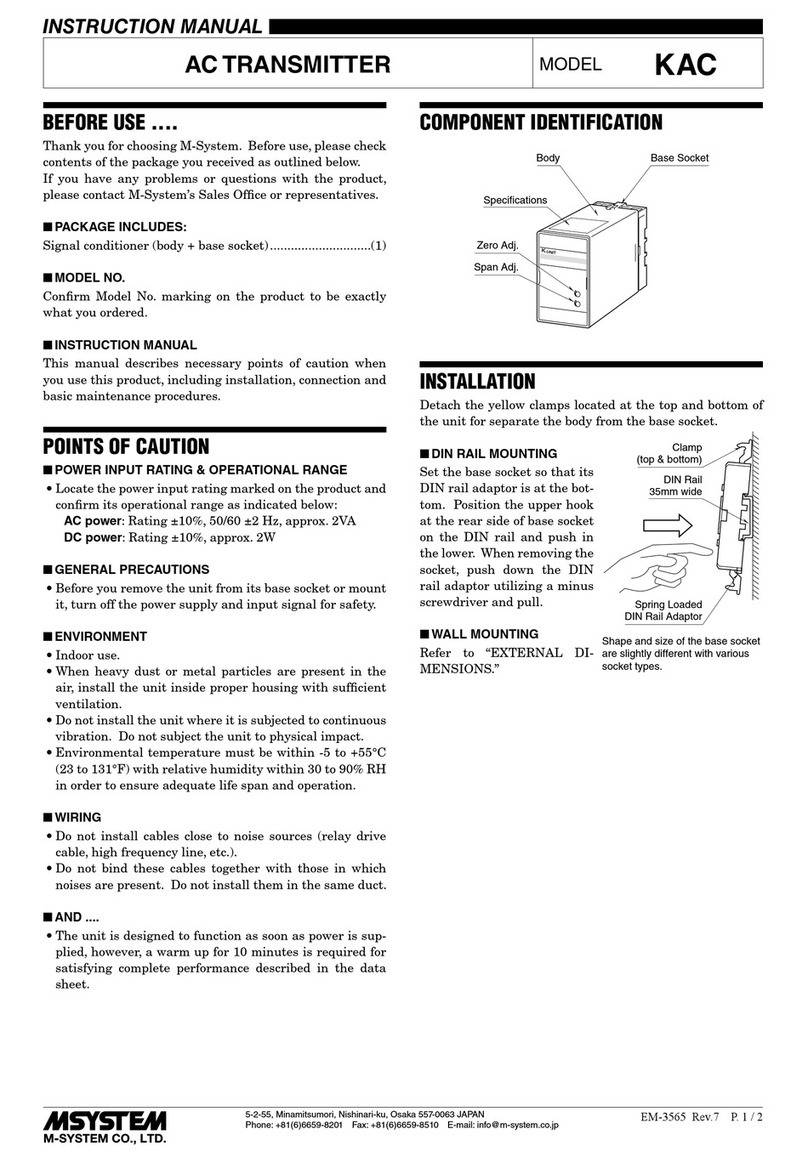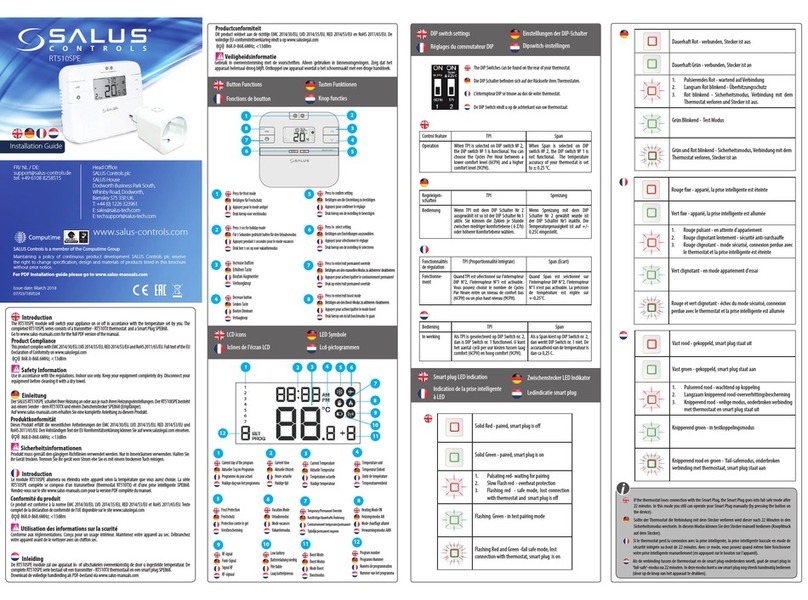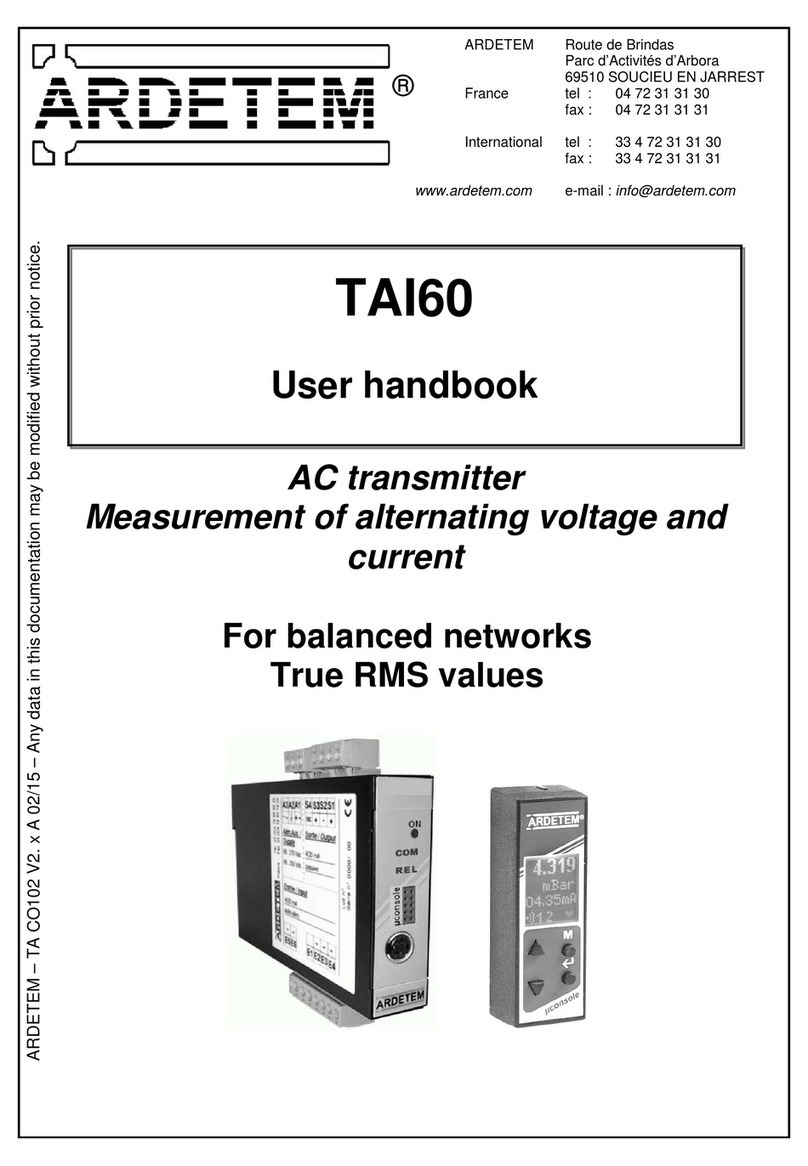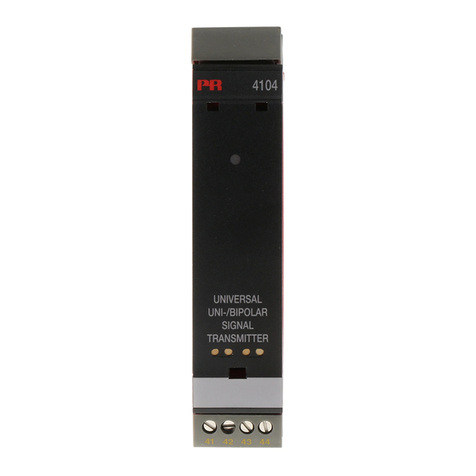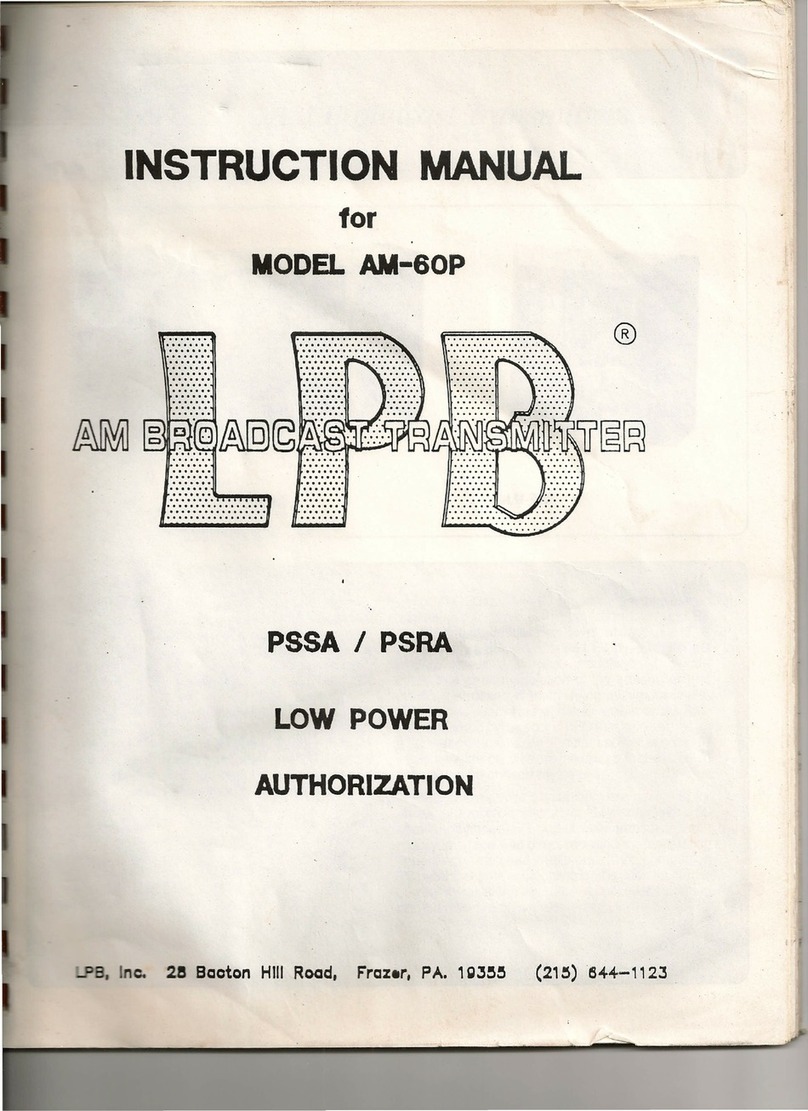Metal Samples MS2601E User manual


Table of
Contents
I. Introduction .............................................................................................................................................. 3
A. General Description ................................................................................................................... 3
B. Principles of Operation .............................................................................................................. 3
C. Technical Specifications ............................................................................................................. 5
II. Installation and Operation ....................................................................................................................... 6
A. Receiving the MS2601E Transmitter ......................................................................................... 6
B. Installation ................................................................................................................................. 6
1. Physical Mounting and Probe Connection................................................................... 6
a. Direct-Probe Mounting ...................................................................................... 6
b. Remote Mounting.............................................................................................. 7
2.Current Loop Connection............................................................................................. 7
a. Making Connections ......................................................................................... 8
b. Grounding ......................................................................................................... 8
c. Wiring for a Safe Area Installation .................................................................... 8
d. Wiring for a Hazardous Area Installation........................................................... 9
3. Setup and Operation..................................................................................................... 11
a. Probe Selection Switches ............................................................................... 11
b. Testing the Current Loop .............................................................................. 12
i. Calibration ............................................................................................... 12
ii. Testing loop output zero (4mA) and span (20mA) ................................. 12
iii. Testing the MS2601E with the Meter Prover .......................................... 12
c. Interpreting Data............................................................................................ 13
i. Metal Loss ................................................................................................ 13
ii. Calculating Corrosion Rate ....................................................................... 13
d. Commissioning .............................................................................................. 15
C. Maintenance ............................................................................................................................ 16
D.Troubleshooting........................................................................................................................ 16
III. Service and Warranty Information ....................................................................................................... 18
A. Warranty................................................................................................................................... 18
B. Obtaining Service and Returning the Instrument for Repair.................................................... 18
C. Instrument Repair Form............................................................................................................ 19
Appendix A – Revision History ................................................................................................................... 20
Appendix B – Hazardous Area Certification Details................................................................................... 21
Appendix C - Drawings ................................................................................................................................ 27
Control Drawing (Hazardous Area Wiring Diagram)..................................................................... 27


3
I. Introduction
A. General Description
The MS2601E is a high-resolution meter designed to transmit corrosion (metal loss) data from an Electrical
Resistance (ER) probe to a plant control system or other recording device. The MS2601E utilizes traditional
4-20mA current loop communication and is loop-powered with built-in isolator, so it requires only a two-
wire interface. This results in a simple and low-cost installation. The use of the 4-20mA protocol also
allows the MS2601E to be placed great distances from the control system or recorder while maintaining
good noise rejection. Practical current loop distances can be many thousands of feet (see pages 6 and 7
for exact specifications.)
The MS2601E is compatible with all types of Metal Samples ER probes, as well as any standard ER probe
from other manufacturers. Unlike competitors’ products, the MS2601E Transmitter does not require
factory modification to accommodate different probe types. The probe type can be easily changed at any
time using the on-board probe selection switches (see page 9.)
The MS2601E is available as direct-mount (standard) or remote-mount. In the direct-mount version the
MS2601E is mounted directly to the ER probe. This option offers the simplest installation and minimizes
noise problems. The remote-mount option allows the MS2601E to be mounted independently from (but in
close proximity to) the ER probe. It is then connected to the probe via a short probe cable. (See page 5 for
mounting diagrams and specifications.)
B.Principles of Operation
The MS2601E operates on the Electrical Resistance (ER) technique and is used in conjunction with an ER
probe. The ER probe utilizes a resistive sensing element manufactured from the material of interest (or a
close approximation) which is exposed to a corroding environment. This is called the Exposed or Corroding
Element. The resistance of the Exposed Element is directly related to its thickness, so as the element
corrodes the resulting loss of metal causes a proportional increase in the element’s resistance. The probe
also contains an internal Reference Element which is used to compensate for the influences of
temperature on the Exposed Element.
The MS2601E is designed to work with any standard ER probe, but it is recommended that Cylindrical and
Large Flush type probes be used to ensure optimum performance. Their physical design places the
Reference Element in closer proximity to the Exposed Element compared to other probe types, providing
more effective temperature compensation and thus reducing the effects of thermal noise.
Because they are designed to corrode, ER probes are sacrificial in nature. Each ER probe will have a finite
life that is based on the element thickness. ER probes are available in a number of geometries and
thicknesses designed to suit a wide variety of applications. Table 1 lists the common ER element options
available from Metal Samples and the effective life of each.

4
Element Type Compatibility Thickness
Probe Life
(Span)
Tubular Loop Compatible
4 2
8 4
Wire Loop Compatible
40 10
80 20
Flush (Small) Compatible
4
2
8
4
20
10
Cylindrical Preferred
10
5
20
10
50
25
Flush (Large) Preferred
5
2.5
10
5
20
10
40
20
Table 1. Standard ER Probe Elements
The MS2601E measures an ER probe utilizing a high-resolution, 16-bit measurement. This allows the
MS2601E to detect much smaller amounts of metal loss, thus responding faster to corrosion events and
upsets (compared to traditional ER meters.) At 16-bit resolution the MS2601E can measure metal loss
amounts as small as 0.0015% of the probe life.
Metal loss readings taken by the MS2601E are converted to a linearized 4-20mA current loop output.
The 4-20mA signal can be fed into a plant control system or other devices and scaled accordingly to
reflect metal loss. Then corrosion rates can be calculated based on the metal loss data over time. This is
covered in more detail on pages 11 and 12.More information on ER probes, their theory, selection, and
use can be found on our web site at http://www.alspi.com/erintro.htm.

5
C. Technical Specifications
Model MS2601E - High Resolution ER 4-20mA Transmitter
Physical Data
InstrumentWeight: 5.25 lb. (2.38 Kg) Total
Weight w/ Accessories: 7.31 lb. (3.31 Kg)
InstrumentDimensions: 9.0"H x 5.3"W x 5.0"D
(22.86cm H x 13.46cm W x
12.70cm D)
OperatingTemperature: -40° to 158°F (-40° to 70°C)
StorageTemperature: -40° to 176°F (-40° to 80°C)
Enclosure Material: Cast Aluminum (Copper-Free)
MountingSpecifications: Direct probe mount or
Remote mount
(Up to a 2.5” (6.35cm) Dia. pole)
Performance Data
Measurement Type: ER measurement using any standard ER probetype
(Wire Loop, Tube Loop, Cylindrical, Flush, Strip, etc.)
Range: 0-100% of probe life
Resolution: 0.0015% of Probe Life (16-bit)
Cycle Time: 1 Minute
Electrical Data
PowerRequirements: 11 to 28 VDC
Nominal ProbeCable Distance: 30 ft (9.1 m)
OutputSpecifications: 4-20mA Current Loop Output
Hazardous Location Certifications
Europe and Worldwide Ex db [ia Ga] IIC T6….T4 Gb
(ATEX and IECEx) Ex tb [ia Da] IIIC T85°C …T130°C Db
- 40°C ≤ Tamb ≤ + 70°C
ATEX Certificate No: ITS14ATEX27981X IECEx
Certificate No: IECEx ITS 14.0010X
USA and Canada Class I, Zone 1, AEx db [ia Ga] IIC T6….T4 Gb
(ETL) Class I, Division 2, Groups A, B, C & D, T6…T4
Hazardous Location Certifications – Enclosure
Case Specifications: Explosion Proof (FM, CSA, UL)
IP 66, NEMA 4X, 7BCD, 9EFG
Included Accessories (Direct-Mount Model)
Meter Prover, Operations Manual
Included Accessories (Remote-Mount Model)
Meter Prover, Operations Manual, Probe Cable, Mounting Hardware Kit

6
II. Installation and Operation
A. Receiving the MS2601E Transmitter
Check the MS2601E Transmitter for any shipping damage when it is first received. When the MS2601E
is unpacked, verify that the following items are included:
•MS2601E Transmitter
•Meter Prover
•User’s Manual
•Probe Cable & Mounting Hardware (optional, for remote-mount only)
In the event of shipping damage, quantity shortage, or missing items, it is recommended that the event
is documented immediately and that digital photographs are taken. Any shortages or missing items
should be reported to Metal Samples immediately. In the event of shipping damage, a claim should be
opened with the responsible carrier.
B. Installation
Warning: Do not open when an explosive atmosphere is present. Potential electrostatic charging hazard.
See instructions. Refer use manual for installation instructions and maximum electrical input & output
parameters.
Attention: ne pas ouvrir en présence d'une atmosphère explosive. Risque potentiel de charge
électrostatique. Voir les instructions. Consultez le manuel d'utilisation pour les instructions d'installation
et les paramètres d'entrée et de sortie électriques maximum.
Installation of the MS2601E Transmitter involves the following steps:
1. Physical Mounting
2. Electrical Connection
3. Setup and Programming
1. Physical Mounting and Probe Connection
When selecting a location to mount the MS2601E it is important to consider the surrounding
environment. To ensure proper operation:
•Do not mount the MS2601E in a location that exceeds its operating temperature.
•Avoid mounting the MS2601E near sources of strong electrical noise.
•Ensure that there is sufficient clearance for installation and to open the transmitter cover
afterwards.
a. Direct-Probe Mounting
The MS2601E is designed for direct-probe mounting which eliminates the need for additional hardware
and transmitter-to-probe cabling. This greatly simplifies installation, reduces costs, and minimizes
electrical noise that can be coupled onto probe cabling from nearby electrical equipment.
Before mounting the MS2601E, first ensure that the probe is installed properly and securely. During
installation it is important that you do not apply excessive force on the probe or seals, as doing so could
break the seal and result in system leakage.

7
To mount the MS2601E:
1. Align the keyways of the transmitter and probe connectors.
2. Insert the transmitter connector plug fully into the probe connector receptacle.
3. Secure the transmitter to the top of the probe by tightening the coupling nut.
NOTE: Hand-tight is sufficient. Do not over-tighten the coupling nut.
NOTE: Never force the connectors to mate. If there is resistance, stop and check for bent pins on
the probe and for foreign material in the female sockets of the transmitter connector. Gently
straighten any bent pins and clear any foreign material that may be found.
Align Key
Insert
Connector
Tighten
Coupling Nut
1 2 3
Figure 2. MS2601E Direct Mount Installation
b. Remote Mounting
When it is not practical to direct-probe mount the MS2601E transmitter, the unit can be remote
mounted instead. In this case the instrument is mounted to a separate mounting pole using the
optional Remote Mounting Hardware Kit. The transmitter is then connected to the ER probe via the
probe extension cable.
Figure 3. Remote Mount Installation

8
2. Current Loop Connection
a. Making Connections
The MS2601E current loop connection wiring enters the transmitter through the 1/2" female NPT
conduit port shown in Figure 4 below. Please refer control drawing for wiring and Terminal
identification.
CAUTION: When used in a hazardous area, the conduit or cable connections must be made in such
a way that all hazardous area requirements are met. Cable Glands and blanking plugs must be
certified for protection types ‘Ex db’ or ’tb’ and it should be rated for IP66.
ATTENTION: Lorsqu'ils sont utilisés dans une zone dangereuse, les connexions des conduits ou
des câbles doivent être réalisées de manière à ce que toutes les exigences relatives aux zones
dangereuses soient satisfaites. Les presse-étoupes et les obturateurs doivent être certifiés pour
les types de protection «Ex db» ou «tb» et doivent être classés IP66.
Probe Connector
Stem or Probe Cable
1/2” FNPT Conduit Port for
Field Wiring Entry
Figure 4. MS2601E current Loop Connector
The maximum permissible length of the current loop wiring between the MS2601E Transmitter and
the control system is determined by the control system supply voltage, the electrical resistance of the
current loop cable and the load of the control system input. If the Transmitter is to be installed in a
safe area, refer to section c. Wiring for a Safe Area Installation for details. If the Transmitter is to be
installed in a hazardous area, refer to section d. Wiring for a Hazardous Area Installation.
b. Grounding
The MS2601E enclosure is grounded internally through the wiring harness, but an additional, external
grounding terminal is provided as well. The enclosure should be grounded properly using the external
grounding terminal to ensure safe operation.
c. Wiring for a Safe Area Installation
For basic safe area wiring information refer to the circuit diagram shown on page 19. Use the following
equation to determine maximum permissible cable length:
=(
10)
(410)()

9
Where:
D = Max. cable length in feet.
VS = Power supply voltage.
R = Cable resistance in ohms per 1000 feet.
Example:
VS = 24 Volts
R = 16.1 (22 AWG cable)
=(24 10)
(410)(16.1)=21,739
d. Wiring for a Hazardous Area Installation
CAUTION: This section provides general guidelines for hazardous area wiring. However, regardless of
anything stated here, the MS2601E must be installed in full compliance with the control drawing
located on page 18 and all of the local area requirements.
ATTENTION: Cette section fournit des directives générales pour le câblage en zone dangereuse.
Cependant, indépendamment de tout ce qui est indiqué ici, le MS2601E doit être installé
conformément au schéma de contrôle situé à la page 18 et à toutes les exigences locales.
Whenever an electrically driven sensor or measuring device is used in a potentially explosive
environment the measuring system must be installed in such a way that electrical energy is either
effectively isolated from the explosive environment (via explosive-proof containers, cable conduits,
etc.) or the amount of electrical energy produced in the hazardous area must be limited to an
permitted level.
Limiting electrical energy is the most practical method of protecting the MS2601E measuring system
when the Transmitter is installed in a hazardous area. In the MS2601E system, electrical energy limits
are maintained using a power supply with Um of 28V installed in the 4-20 mA current loop per
standard practice. The voltage shall be maintained all the time in accordance with the guidance given
in IEC 60079-14.
Caution: In general Safety barriers are not necessary but when a safety barrier is used with the
MS2601E system, the current loop cable must be connected to the barrier’s hazardous area terminals
and the barrier output voltage should not exceed 28V at any circumstances. All other connections
must be made to the barrier’s safe area terminals.
The type of repeater safety barrier employed in the MS2601E system depends on the specific
classification of the hazardous environment in question. Metal Samples will provide, upon request,
assistance and technical advice in the selection of a repeater safety barrier or its equivalent.
The maximum length of the current loop cable that connects the MS2601E Transmitter to the
repeater safety barrier is as follows:

10
Example:
17.5 Volts
22 AWG Cable = 5,434 feet maximum
16 AWG Cable = 21,788 feet maximum
CAUTION: For hazardous area installations, the maximum inductance and capacitance of the loop
wiring between the safety barrier and the transmitter cannot exceed the entity parameters of the
selected barrier.
ATTENTION: Pour les installations en zone dangereuse, l'inductance et la capacité maximales du
câblage de la boucle entre la barrière de sécurité et le transmetteur ne peuvent pas dépasser les
paramètres d'entité de la barrière sélectionnée.
3. Setup and Operation
a. Probe Selection Switches
Housed within the MS2601E enclosure are probe selection switches which allow the instrument to be
set for any standard ER probe type. They also allow the instrument to be placed into several test
modes which output fixed values, allowing verification of the current loop connection and DCS
program.
Figure 5. Connector and Switch Details
Probe Selection Switch
(See detail below)
4-20mA Current
Loop Connector
Probe Cable Connector

11
Setting
Switch
1
Switch
2
Switch
3
Switch
4
Operating
Positions
Wire Loop Off (↓)On (↑) On (↑) Off (↓)
Tube Loop/Flush On (↑) Off (↓)On (↑) Off (↓)
Cylindrical*Off (↓)Off (↓)On (↑) Off (↓)
Test
Positions
4mA Output On (↑) On (↑) Off (↓)Off (↓)
20mA Output Off (↓)On (↑) Off (↓)Off (↓)
4-20mA Sweep On (↑) Off (↓)Off (↓)Off (↓)
Table 2. Probe Switch Settings
*Cylindrical probe setting is illustrated.
b. Testing the Current Loop
i. Calibration
The MS2601E is fully calibrated when shipped from the factory. The calibration settings are fixed to
avoid accidental change which could result in erroneous data. In general no field calibration is
required.However, it is important to test the MS2601E upon installation, and during periodic
maintenance inspections, to ensure the unit is operating properly. Follow the procedure as below, if
calibration becomes absolute necessary.
Note1: Note down the switch settings before proceeding to the below procedure.
1) 4 .00 mA Calibration
a. Power down the instrument
b. Turn Off Switch 1 ,2 and 3
c. Turn On Switch 4
d. Connect meter in series to the instrument to measure current in mA.
e. Power-up the instrument
f. Check the Loop Current, No calibration necessary if the meter reads 4.00 mA, if
not proceed below.
g. To increase the loop current in steps of 0.025 mA , toggle the Switch - 2 to Up and
Down . Each Toggle will increase loop current by 0.025mA
h. To decrease the loop current in steps of 0.025 mA , toggle the Switch - 3 to Up and
Down . Each Toggle will decrease loop current by 0.025mA
i. Ensure current reading is equal to 4.00 mA.
j. Turn Off Swithc-4. Wait for a second
k. Turn off the Power.
2) 20 .00 mA Calibration
a. Power down the instrument
b. Turn Off Switch 2 and 3
c. Turn On Switch 1 and 4
d. Connect meter in series to the instrument to measure current in mA.
e. Power-up the instrument
f. Check the Loop Current, No calibration necessary if the meter reads 20.00 mA, if
not proceed below.

12
g. To increase the loop current in steps of 0.025 mA , toggle the Switch - 2 to Up and
Down . Each Toggle will increase loop current by 0.025mA
h. To decrease the loop current in steps of 0.025 mA , toggle the Switch - 3 to Up and
Down . Each Toggle will decrease loop current by 0.025mA
i. Ensure current reading is equal to 20.00 mA.
j. Turn Off Swithc-4 and wait for a second
k. Turn off the Power.
Now the new calibration values registered in the non-volatile memory.
Note2: Set the Switch with respect to probe connected to the instrument before put into
service.
ii. Testing loop output zero (4mA) and span (20mA)
The MS2601E Probe Selection Switches (page 9) offer three test settings that allow the unit to be
placed into various diagnostic modes as follows:
1) 4mA Output – Forces a constant 4mA output on the current loop.
2) 20mA Output – Forces a constant 20mA output on the current loop.
3) 4-20mA Sweep – Causes the output to continually cycle from 4mA up to 20mA.
These test modes can be useful when troubleshooting problems with the current loop wiring and
DCS/SCADA system.
iii. Testing the MS2601E with the Meter Prover
A Meter Prover is provided to allow routine checks of the MS2601E. The Meter Prover simulates a
Wire Loop type probe at a fixed value. To test the MS2601E with the Meter Prover:
1) Disconnect power.
2) Disconnect the MS2601E from the probe (or if the MS2601E is remote-mounted, disconnect
the probe extension cable from the probe.)
3) Connect the Meter Prover to the MS2601E probe connector stem (or to the probe extension
cable if the MS2601E is remote-mounted.)
4) Loosen the MS2601E Enclosure Lock Screw.
5) Unthread and remove the MS2601E cover.
6) Change the Probe Selection Switches to the Wire Loop position (see page 9.)
7) Reconnect power and allow the instrument to measure for several minutes to stabilize.
8) After several minutes observe the transmitter output. The output should closely match the
value printed on the Meter Prover label.
If the transmitter output matches the Meter Prover value, you may return the Probe Selection
Switches to their previous setting and reconnect the MS2601E to the probe. If the transmitter output
shows a significant difference compared to the Meter Prover value, further troubleshooting may be
required. Refer to page 14 for troubleshooting or contact the factory for further assistance.
Be sure to reinstall the enclosure cover and tighten the Lock Screw when putting the MS2601E back
into service.

13
c. Interpreting Data
i. Metal Loss
The MS2601E measures the Metal Loss of an ER probe and converts that value to a linearized 4-20mA
current loop output. The 4-20mA output is directly proportional to the cumulative Metal Loss of the
ER probe at any given time. The overall span of the 4-20mA output is proportional to the life of the
probe in use, so for DCS/SCADA programming the 4-20mA signal can be scaled as follows:
4mA = 0 mils (0% Metal Loss)
20mA = Probe Life in mils (100% Metal Loss)
The Probe Life can be found in Table 1 and is also listed on the Metal Samples probe tag (as the
“Multiplier”.)
Figure 6. Metal Samples Probe Tag
Figure 7 illustrates the relationship between Loop Current and Metal Loss. In this example a probe
with a 10-mil life is assumed. However, the X axis could be changed to represent any Probe Life.
Figure 7. Output Relationship
As seen here, the transmitter output begins at 4mA for a new probe (zero Metal Loss) and increases as
the probe element corrodes, eventually reaching a maximum of 20mA when the probe sensing
element has been completely consumed by corrosion (in this case, 10 mils of Metal Loss.) At this time
the probe has reached its end-of-life and must be replaced.

14
ii. Calculating Corrosion Rate
As explained previously, ER probes and instruments report Metal Loss. However, the value that is of
ultimate interest is Corrosion Rate. The Corrosion Rate is essentially Metal Loss over time, so the
Corrosion Rate can be calculated using the following formula:
Corrosion Rate(mpy) =
Loop Current(mA)
16 ×365
Time(days) ×Probe Life(mils)
where:
∆
Loop Current(mA) is the difference between two readings
∆
Time(days) is the time difference between those two readings
It is a common practice to program this formula into the control (DCS/SCADA) system and have it
calculate Corrosion Rate on a continual basis from the Metal Loss data. The challenge in doing this is
selecting an appropriate time interval. Using an interval that is too short may give erratic results,
while selecting an interval that is too long may give results that are insensitive to system upsets. The
ideal time period depends on many factors, and will vary from system to system. It may take some
trial and error to settle on the best time period for your installation.
In some cases it may be necessary to review the raw Metal Loss data and manually apply the
Corrosion Rate formula to periods of interest. For example, look at the graph below and see how
much the calculated Corrosion Rate can vary depending on the time period used.
Figure 8. Corrosion Rates calculated from Metal Loss data
While each of the results is valid for the selected time period, the one of most interest is the value of
11.81 mpy which represents some type of system upset. When the Corrosion Rate is calculated
automatically on a pre-selected time period, there is no guarantee that the selected time period will
always coincide with system upsets such as this. That is why manual review and interpretation of
Metal Loss data is also helpful.

15
d. Commissioning
Once the MS2601E transmitter has been installed, tested, and properly configured for the probe
in use, it can then be closed and put into service. First, perform one last visual inspection to
ensure that all electrical connections are secure and that the enclosure o-ring is in place and is in
good condition. Then thread the enclosure lid onto the base fully. Once the lid has been
threaded into place, tighten the Lock Screw to prevent unauthorized tampering.
Figure 10. Enclosure
Lock
Screw
CAUTION: The Lock Screw on the instrument base must be tightened securely to prevent
unauthorized personnel from opening the MS2601E transmitter, and ensure that the Flameproof
safety is not violated. Only qualified personnel should be allowed to install, operate, and
maintenance the MS2601E transmitter.

16
C. Maintenance
Once installed, the MS2601E requires little maintenance. However, it is important to verify the following
items periodically to ensure continued safe operation.
CAUTION: Before performing any tests or maintenance on the MS2601E, ensure that all hazardous area
requirements are met.
Inspection Item
Frequency
Inspect the enclosure o-ring for any signs of damage. Replace as necessary.
Annually
Inspect the probe connector o-ring for any signs of damage. Replace as necessary.
Annually
Inspect all electrical connections for signs of corrosion, mechanical damage, or foreign
matter that could cause improper operation or cause an electrical short. Clean as necessary.
Annually
Ensure that the locking screw is in place and is secure.
Annually
Inspect the enclosure for any signs of corrosion or paint damage.
Annually
Check for any signs of moisture ingress within the enclosure.
Annually
Contact Metal Samples for replacement parts or if instrument repair is necessary.
D. Troubleshooting
If the MS2601E does not seem to perform as expected, check the following items:
CAUTION: Before performing any tests or maintenance on the MS2601E, ensure that all hazardous
area requirements are met.
ATTENTION: avant d'effectuer des tests ou des opérations de maintenance sur le MS2601E, assurez-
vous que toutes les exigences relatives aux zones dangereuses sont respectées.
1. Ensure that the probe is operational and is not completely corroded. This can be done in two
ways.
a. Test the probe with a portable ER meter if available.
b. Test the probe with a portable resistance or continuity meter as follows:
i. Connect one test lead to pin ‘A’ of the probes 6-pin connector.
ii. Measure continuity to each of the other pins. There should be continuity (low
resistance) to each pin.
NOTE: Continuity on each pin does not ensure that the probe is good. However, if
you find an open circuit on any pins then it is almost certain that the probe is bad and
should be replaced.
2. Ensure that the Probe Selection Switches are set correctly for the probe being used. Confirm
the probe type, and refer to Table 2 on page 9 to verify the appropriate switch settings.
3. Perform a visual inspection of the circuit boards to look for any signs of mechanical or
electrical damage.
4. Ensure that all electrical cables and wiring are in good condition.
5. Ensure that all electrical contacts are secure and free of corrosion.

17
6. Ensure that there is adequate supply voltage at the 4-20mA Current Loop Connector.
7. Verify that the supply voltage polarity is correct.
8. If there is insufficient supply voltage on the 4-20mA Current Loop Connector, check the safety
barrier (if applicable) for a blown fuse or any other failure.
9. Test the MS2601E using the supplied Meter Prover (see page 10.)
10. Test the MS2601E with a local multi-meter or loop calibrator.
These basic checks should indicate the source of any problem (probe, power supply, wiring, etc…) If it
is determined that the MS2601E is malfunctioning, or if you need further assistance in
troubleshooting, contact Metal Samples Technical Support.
CAUTION: If the MS2601E shows any signs of damage remove it from service immediately and consult
the factory.
ATTENTION: Si le MS2601E montre des signes de dommages, mettez-le immédiatement hors service et
consultez l'usine.

18
III. Service and Warranty Information
A. Warranty
Metal Samples warrants that any part of the MS2601E and accessories which proves to be defective in
material or workmanship within one year of the date of original shipment to Purchaser will be
repaired or replaced, at Metal Samples option, free of charge. This warranty does not cover (1) probe
assemblies, (2) items expendable in nature, or (3) items subject to damage from normal wear, misuse
or abuse, or failure to follow use and care instructions.
All damaged items are to be shipped at Purchaser’s expense to and from Metal Samples which shall
have the right to final determination as to the existence and cause of a defect.
The foregoing shall constitute the sole and exclusive remedy of any purchaser of Metal Samples
products for breach of warranty and IS EXCLUSIVE AND IN LIEU OF ALL OTHER WARRANTIES,
EXPRESSED, IMPLIED OR STATUTORY, INCLUDING THE IMPLIED WARRANTIES OR MERCHANTABILITY
AND FITNESS. IN NO EVENT SHALL METAL SAMPLES BE LIABLE FOR SPECIAL OR CONSEQUENTIAL
DAMAGES, OR FOR ANY DELAY IN THE PERFORMANCE OF THIS WARRANTY DUE TO CAUSES BEYOND
ITS CONTROL.
The technical information and suggestions contained herein are believed to be reliable, but they are
not to be construed as warranties since conditions of use are beyond our control.
B. Obtaining Service and Returning the Instrument for Repair
If you experience problems with your instrument please contact the factory at 256-358-4202 and ask
for customer support for instrumentation. Our customer support department will assist you in
troubleshooting your instrument.
Most issues can be resolved over the phone, but in some cases it may be necessary to return your
instrument for further evaluation and repair. In this case, please obtain a Return Materials
Authorization (RMA) number from the sales person or support technician. This RMA number will
ensure that your instrument is routed to the correct department when it is received at the factory.
After receipt of an RMA number you may pack your instrument for return. Be sure to pack your
instrument in a sturdy box and to pad it sufficiently to avoid damage during transit. Also be sure to
complete the “Instrument Repair Form” on the next page and include a copy with your repair. This
will ensure that the repair department has sufficient information regarding the problems you are
experiencing with your instrument, as well as the billing, contact, and return shipping details for the
repair.
Once you have obtained an RMA number, completed the “Instrument Repair Form”, and packed your
instrument securely, please ship it prepaid to the following address:
Metal Samples
152 Metal Samples Road
Munford, AL 36268
ATTN: RMA# _ _ _ _ _
NOTE: Be sure to list your RMA number in the attention line (shown as blanks in the example above.)
Table of contents
Other Metal Samples Transmitter manuals

Metal Samples
Metal Samples MS2600E User manual
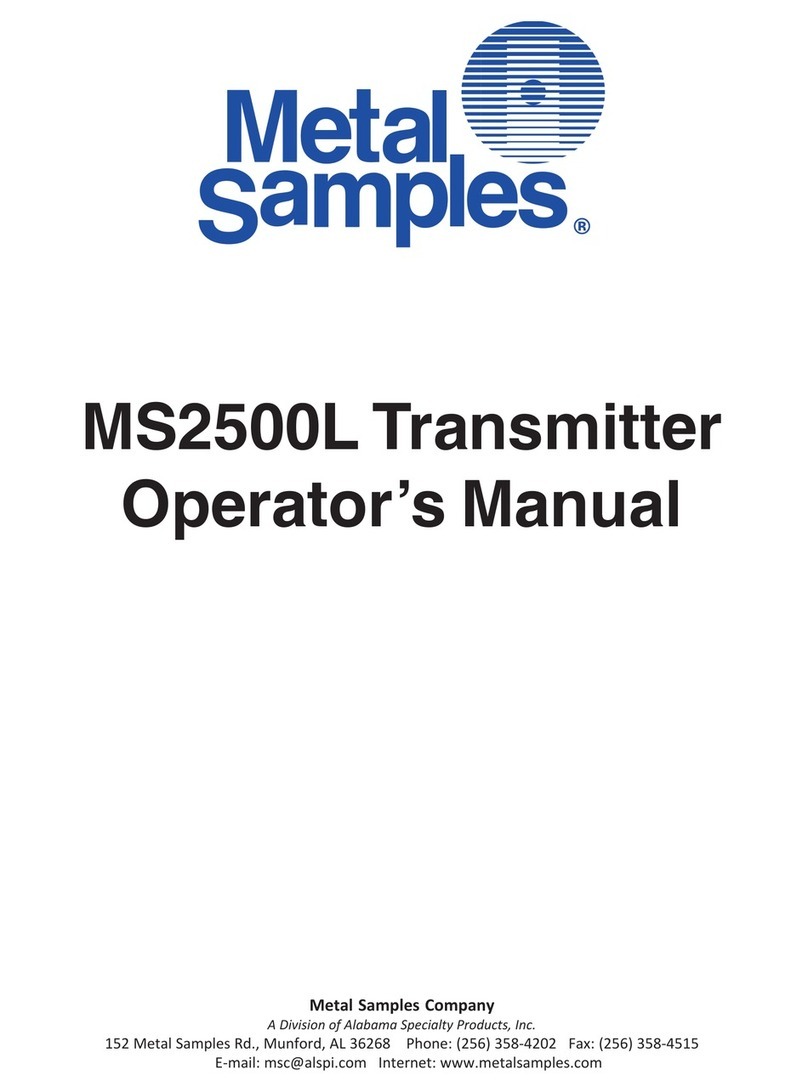
Metal Samples
Metal Samples MS2500L User manual
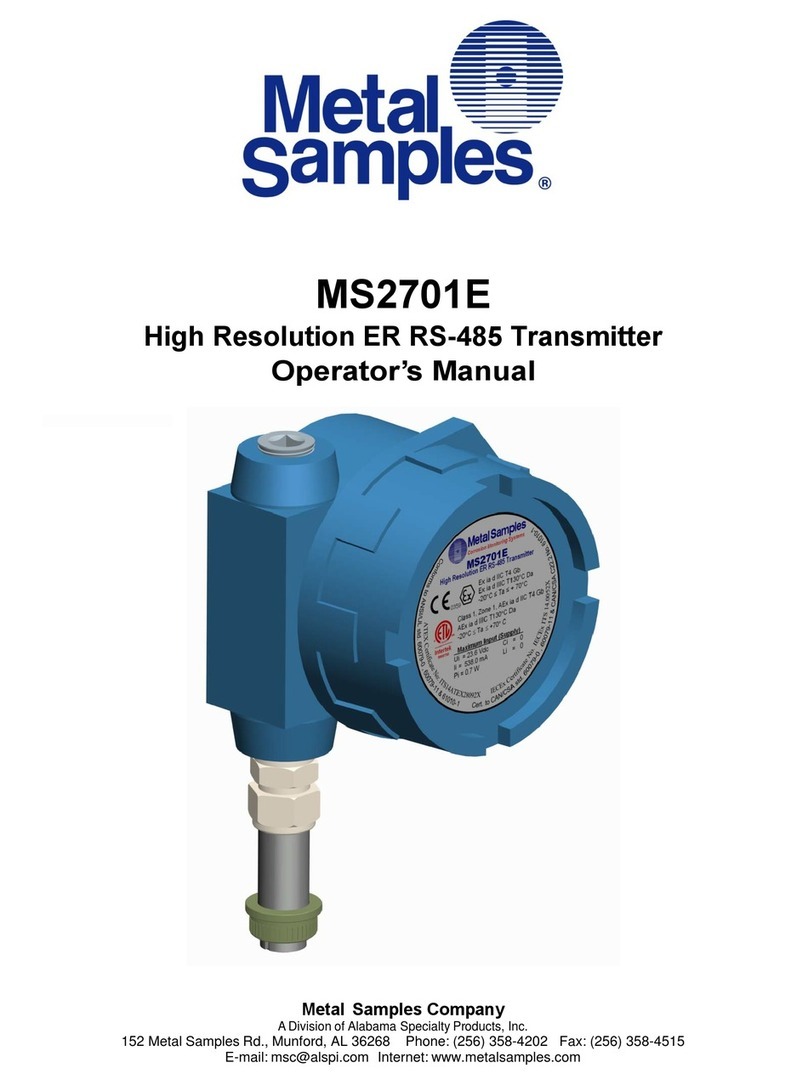
Metal Samples
Metal Samples MS2701E User manual
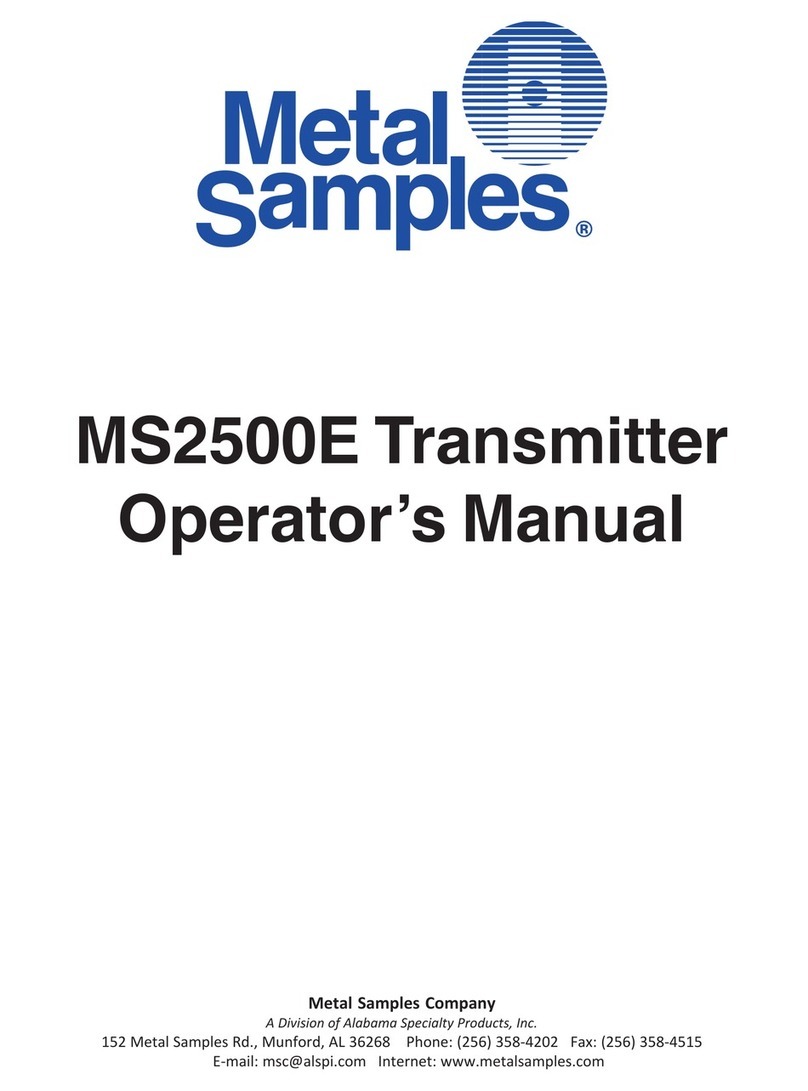
Metal Samples
Metal Samples MS2500E User manual

Metal Samples
Metal Samples MS2901E User manual
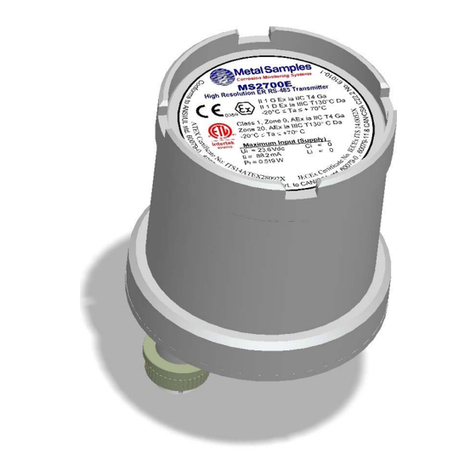
Metal Samples
Metal Samples MS2700E User manual
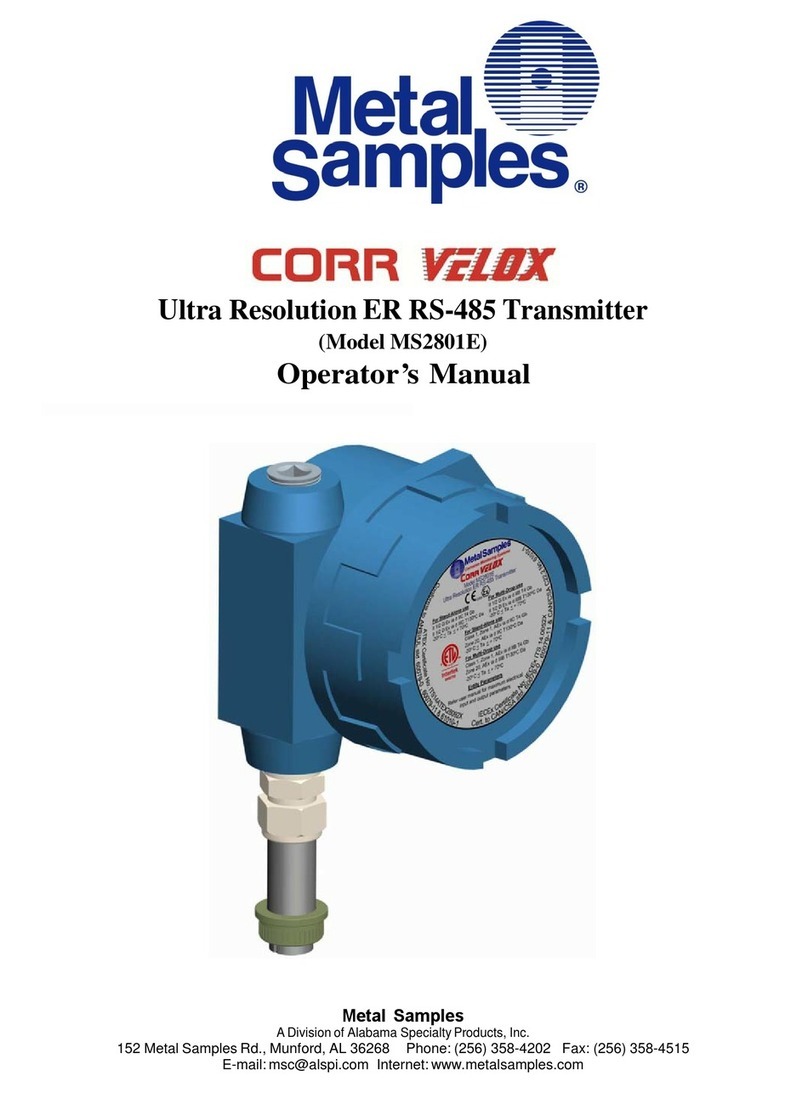
Metal Samples
Metal Samples CORR VELOX MS2801E User manual
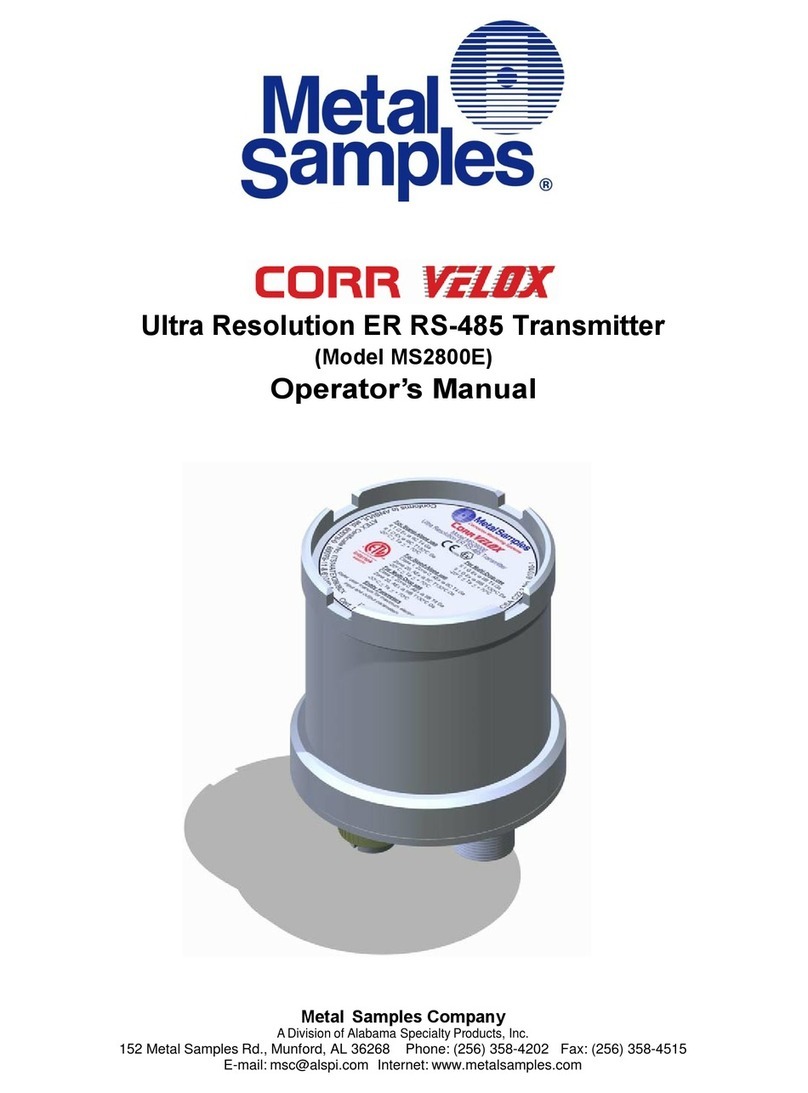
Metal Samples
Metal Samples CORR Velox MS2800E User manual



